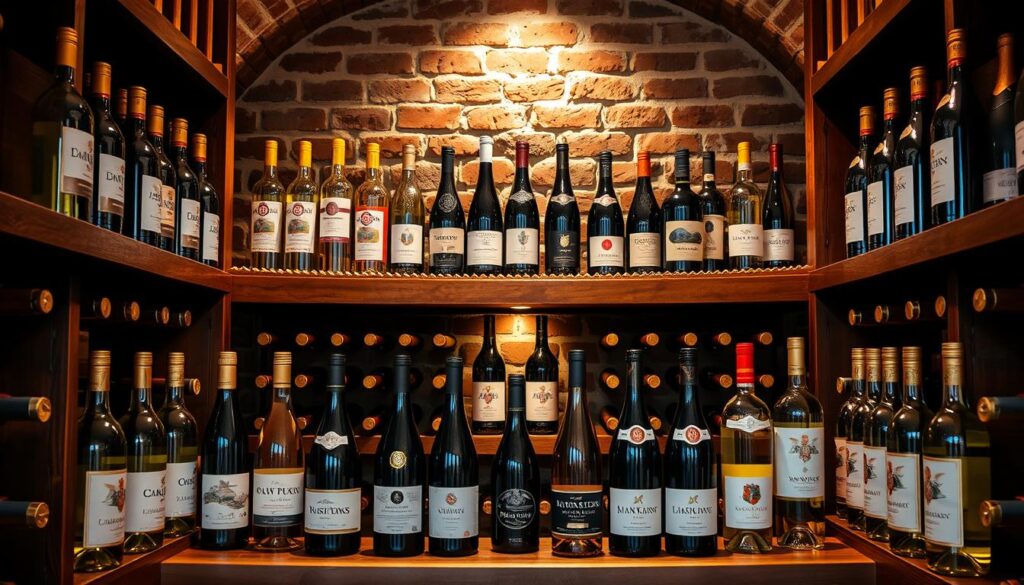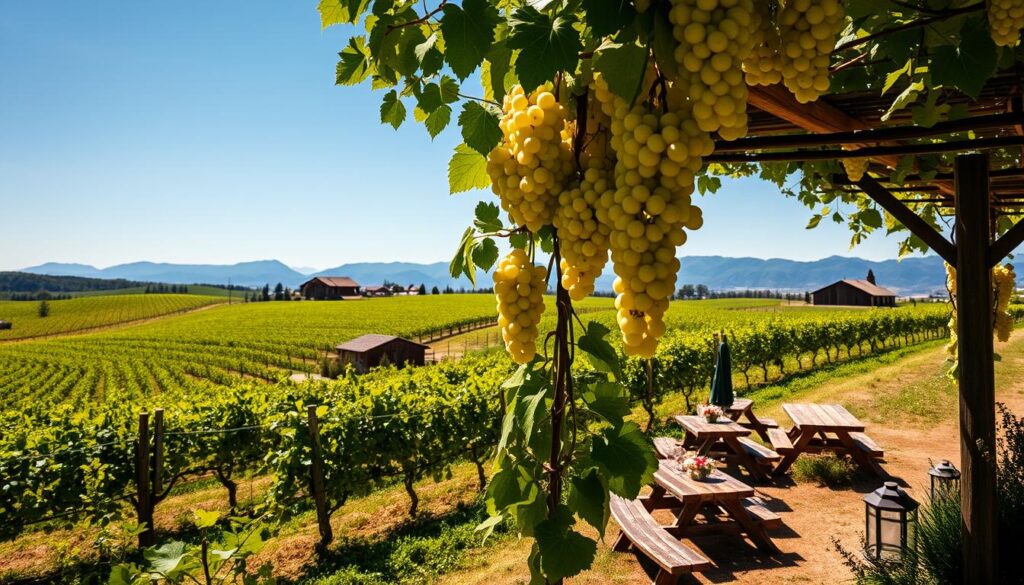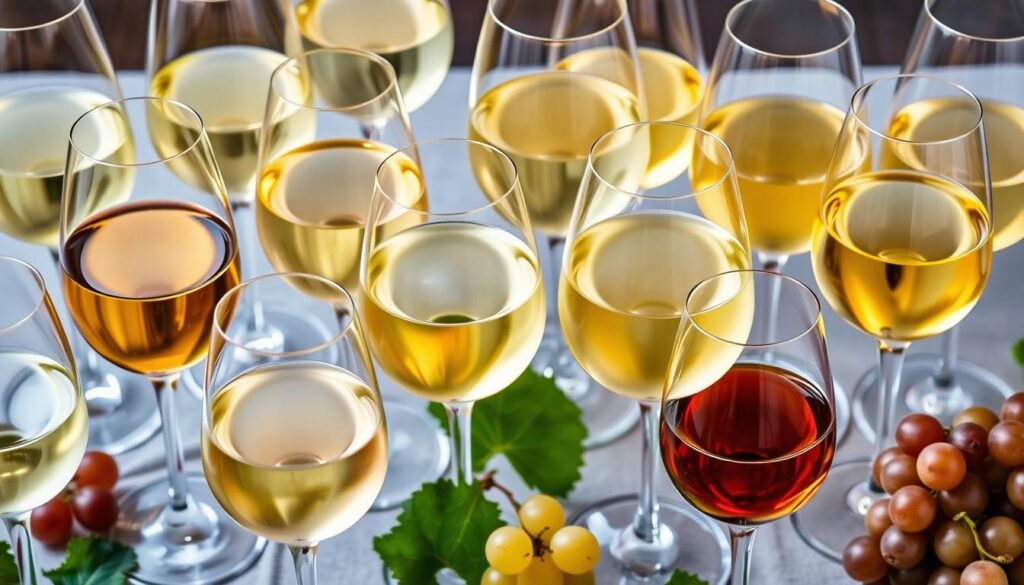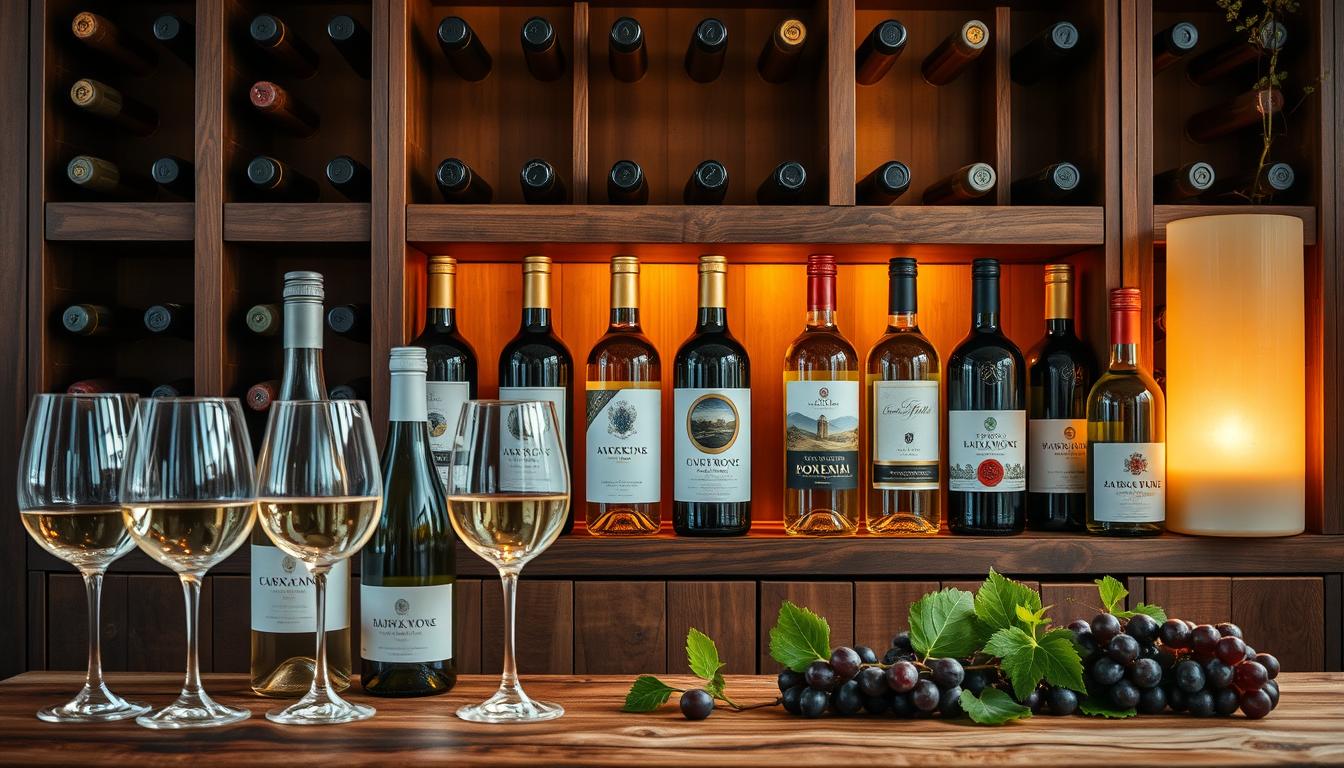Have you ever found yourself captivated by the shimmering golden hue of a glass of white wine? The way it catches the light, promising refreshing aromas and flavors that dance on your palate. It’s these moments that transform a simple dinner into a cherished memory, whether you’re embracing a milestone with friends or winding down after a long day. With a world of white wine varieties at your fingertips, it’s time to embark on a journey toward discovering the best white wines to enrich your collection.
In this guide, we will explore not just the myriad options available, but the stories behind them—each bottle a reflection of its unique origin, the winemaker’s passion, and the land from which it comes. From the popular favorites like Chardonnay and Sauvignon Blanc to lesser-known gems, you’ll find tips to enhance your appreciation and enjoyment of white wines. Let’s raise a glass to the delightful adventure ahead!
Key Takeaways
- Discover the various types of white wines that can elevate your collection.
- Learn about award-winning white wines recognized for their quality and flavor.
- Appreciate unique characteristics of different white wine varieties.
- Explore regions known for producing exceptional white wines.
- Find practical tips on storing and tasting white wines.
- Understand the benefits of incorporating white wines into your lifestyle.
Introduction to White Wines
White wines have captivated wine lovers for centuries. This introduction to white wines highlights the diversity present in this category. Typically produced from green or yellow grapes, white wines can range in flavor from crisp and floral to rich and buttery. The outcome largely depends on factors such as grape variety, climate, and winemaking techniques.
A white wines overview reveals that these beverages often complement light dishes perfectly, making them a popular choice for pairing with seafood, salads, and poultry. Understanding the different styles of white wines allows you to enrich your tasting experience. With options like Chardonnay, known as the world’s most popular white wine, and Sauvignon Blanc, celebrated for its freshness and grassy notes, the choices available are vast.
As you explore these delightful options, consider the impact of aging on white wines. Aging can transform the flavor and aroma, with oak barrels often imparting subtle complexities. The acidity levels, determined during the grape ripening stage, can influence how well a wine pairs with food. A well-chosen white wine not only enhances your meal but also heightens your overall dining experience.

Why White Wines Matter in a Collection
Including white wines in your wine collection is essential due to their versatility and diversity. Around the world, the importance of white wines is evident as they often outpace red wines in sales, particularly in regions like the US and UK. For every five bottles of red wine sold, four bottles of white wine fly off the shelves, highlighting their greater demand and popularity among consumers.
White wines are known for their ability to pair beautifully with various dishes, making them an excellent option for any dining occasion. Their refreshing character allows them to complement a wide range of flavors, adding depth to multi-course meals. This adaptability reinforces the significance of having an extensive white wine collection.
Wine enthusiasts recognize the unique qualities of white wines, such as their varied sweetness, fizziness, and maturity levels. This wide range results in options for all palates, from crisp and light selections to rich and creamy choices. Additionally, the ageability of certain white wines, like German Riesling and Sauternes, demonstrates their potential to enhance a collection’s value.
Statistical analyses indicate a disparity in the review scores of white and red wines, often favoring red wines. Despite this bias, the aromatic complexity and texture of white wines challenge the traditional perceptions. Wine critics may have historically focused on red wines, but this only enhances the allure of white wines in a collector’s pursuit.

Types of White Wines You Should Know
Understanding the different types of white wines enhances your appreciation of this beloved beverage. Each variety presents unique flavor profiles and characteristics, catering to various preferences. Among these types are several popular white wine varieties that stand out for their distinct qualities.
Popular Varieties of White Wines
Exploring the popular white wine varieties helps you navigate the vast world of white wines. Here are some essential ones to consider:
- Chardonnay: Widely planted around the world, this versatile grape variety is famous for its adaptability and is crucial to champagne production.
- Sauvignon Blanc: Known for its vibrant acidity, this grape varies in style based on its region, featuring different flavor notes across North and South America, New Zealand, and France.
- Riesling: This renowned German grape is celebrated for both still and sparkling wines, offering a range of sweetness levels, making it a favorite among many wine lovers.
- Pinot Grigio: Recognized for its crispness, this variety showcases a bright citrus fruit spectrum, perfect for refreshing summer sips.
- Gewürztraminer: Historically famous in Germany and Alsace, this aromatic wine often features floral and spice notes.
- Chenin Blanc: This adaptable grape can produce dry or sweet wines and is striking in both still and sparkling forms.
- Viognier: Found in Northern Rhône wines, this varietal offers rich aromatics and stone fruit flavors.
- Semillon: Frequently associated with Bordeaux blends, it is often mixed with Sauvignon Blanc for depth of flavor.
Sweet vs. Dry White Wines
The distinction between sweet vs dry white wines significantly influences your wine selection process. Knowing this can help tailor your experience according to your taste preference. Sweet white wines are characterized by a higher sugar content and include varieties like Riesling and Gewürztraminer, which provide floral and fruity aromas. They pair well with spicy foods or desserts.
In contrast, dry white wines such as Sauvignon Blanc and Chardonnay offer more acidity and pronounced flavors, making them excellent companions for seafood and poultry dishes. Both categories bring unique qualities to the table, ensuring there’s a perfect match for every meal or occasion.

| White Wine Variety | Flavor Profile | Common Regions |
|---|---|---|
| Chardonnay | Buttery, fruity | Worldwide, Champagne |
| Sauvignon Blanc | Citrusy, herbal | Bordeaux, Loire Valley, New Zealand |
| Riesling | Floral, fruity | Germany, Australia |
| Pinot Grigio | Crisp, zesty | Italy, California |
| Gewürztraminer | Aromatic, spicy | Alsace, Germany |
| Chenin Blanc | Varied, fruity | Loire Valley, South Africa |
| Viognier | Floral, rich | Rhône Valley, California |
| Semillon | Waxy, honeyed | Bordeaux, Australia |
Top White Wine Varieties to Collect
When embarking on your journey to collect white wines, focusing on notable varieties will enhance your experience. The top white wine varieties each bring unique characteristics, making them exceptional choices for any collection.
Chardonnay: The King of White Wines
Considered the king among white wines, Chardonnay boasts versatility and elegance. It is praised for its ability to reflect its terroir. Versions from California, where Rombauer sets a benchmark for style, typically exhibit rich, buttery flavors. A Chardonnay from the Willamette Valley showcases star-quality attributes. For collectors, its aging potential is remarkable, with quality scores often reaching 95 points and above.
Sauvignon Blanc: A Crisp Classic
As one of the essential top white wine varieties, Sauvignon Blanc stands out for its crisp acidity and herbal notes. Originating primarily from Bordeaux and the Loire Valley, it complements a wide array of palettes. This variety thrives in various settings, making it a cornerstone for anyone looking to collect white wines.
Riesling: A Versatile Choice
Riesling remains a favorite due to its adaptability. Whether from Germany, showcasing sweet profiles, or drier versions from Alsace, this grape offers a range of expressions. Its aging potential is recognized, with many Rieslings maturing beautifully over time. With an ability to score high in tastings, this wine provides a delightful experience for those seeking the best white wine choices.
Pinot Grigio & Pinot Gris: A Zesty Duo
This duo of varieties exhibits bright flavors and zesty profiles, making them excellent companions for various dishes. Whether you prefer the Italian style of Pinot Grigio or the fuller-bodied Pinot Gris from Alsace, both offer refreshing tasting experiences. For collectors, these wines add a splash of vibrancy and adaptability, ensuring a well-rounded collection of white wines.

Exploring White Wine Regions
Understanding the various white wine regions enriches your appreciation for different wines. Each wine-producing region possesses unique characteristics that shape the flavors and styles of white wines. From France to New Zealand, the diversity of regional wine characteristics provides a delightful journey for any wine enthusiast.
Key Regions Known for White Wines
Some renowned white wine regions are celebrated for their extraordinary offerings:
- Loire Valley, France: Known for its diverse Sauvignon Blancs and Chenin Blancs, this region boasts numerous AOC appellations focusing on high-quality white wines.
- Burgundy, France: Famous for its exceptional Chardonnay, especially from Chablis, which showcases distinctive styles.
- Napa Valley, California: A prominent region in the U.S. revered for its diverse Chardonnay, ranging from crisp and fruity to rich and oaky.
- Marlborough, New Zealand: The world capital of Sauvignon Blanc, producing vibrant wines that highlight the region’s unique terroir and climate.
- Pfalz, Germany: Renowned for high-quality Rieslings that blend structure, richness, and freshness.
Unique Characteristics of Different Regions
Each white wine region brings something special to the table:
| Region | Key Grape Varieties | Distinctive Flavor Profiles | Notable Characteristics |
|---|---|---|---|
| Loire Valley, France | Sauvignon Blanc, Chenin Blanc | Herbaceous, mineral-driven | Diverse AOC appellations |
| Burgundy, France | Chardonnay | Fruity, buttery, complex | Unique styles from Chablis |
| Napa Valley, California | Chardonnay | Rich, full-bodied, oaky | Home of American winemaking |
| Marlborough, New Zealand | Sauvignon Blanc, Chardonnay | Tropical, vibrant, refreshing | Diverse wine production |
| Pfalz, Germany | Riesling | Fruity, floral, structured | Second largest wine-growing region |

Best White Wine Brands to Consider
Finding the right brands to enhance your wine collection involves exploring the offerings from both notable white wine producers and value brands. Many of these producers deliver exceptional quality white wine options that cater to a variety of tastes and preferences. Understanding the market can guide you toward the best selections for your palate and budget.
Noteworthy Producers of White Wines
Several notable white wine producers stand out for their commitment to quality and consistency. Consider the following:
- Domaine Serene: Renowned for their meticulously crafted Chardonnay, consistently scoring high in reviews.
- Chateau Montelena: A classic producer known for its elegant and full-bodied Chardonnay, capturing the essence of Napa Valley.
- Eisele Vineyard: Specializes in Sauvignon Blanc, with recent vintages receiving top accolades and ratings.
- Hamilton Russell: Praised for its superb Chardonnay, known for its balance and complexity.
Value Brands that Deliver Quality
Alongside high-end brands, some value brands offer quality white wine options without breaking the bank. They make excellent choices for those looking to round out their collection:
- Kim Crawford: Offers solid Sauvignon Blanc that is accessible and flavorful.
- La Crema: Known for a wide range of Chardonnay offerings that maintain quality at a reasonable price.
- Livio Felluga: Their Pinot Grigio Curubella is well-received, presenting a great balance of style and drinkability.

Exploring these best white wine brands will elevate your collection. With options from notable white wine producers to excellent value brands, you can enjoy the rich diversity and exceptional quality of white wines available today.
| Producer | Variety | Average Rating | Price Range |
|---|---|---|---|
| Domaine Serene | Chardonnay | 94.6 | $50 |
| Chateau Montelena | Chardonnay | 94 | $75 |
| Eisele Vineyard | Sauvignon Blanc | 97 | $60 |
| Hamilton Russell | Chardonnay | 95 | $65 |
| Kim Crawford | Sauvignon Blanc | 92 | $22 |
| La Crema | Chardonnay | 93 | $30 |
| Livio Felluga | Pinot Grigio | 95 | $40 |
Understanding White Wine Tasting Notes
Exploring white wine tasting notes allows you to truly appreciate the diversity in flavor characteristics among different varieties. When tasting white wines, pay attention to the aroma components such as floral, fruity, or herbal notes. Understanding these details enriches your wine experience and helps in selecting bottles that align with your palate.
What to Look for in Tasting Notes
When evaluating a wine, start by observing the visuals, then move on to the aromas, and finally, take a sip. Each component contributes to the overall tasting experience:
- Color: Observe the intensity and hue. Lighter colors often indicate youthful wines.
- Aroma: Look for fragrant hints of fruit, flowers, and spices.
- Flavor: Identify dominant flavors such as citrus in Sauvignon Blanc or stone fruits in Riesling.
- Finish: Note the aftertaste; a longer finish often signifies a higher quality wine.
Common Flavor Profiles in White Wines
White wine tasting notes can help you recognize the common flavor profiles across various styles:
| Wine Variety | Flavor Characteristics |
|---|---|
| Chardonnay | Creamy and buttery, with hints of oak. |
| Sauvignon Blanc | Bright acidity with zesty grapefruit and green herbs. |
| Moscato | Sweet orange flavors with a fresh and bright aroma. |
| Pinot Grigio | Citrusy and crisp, often with green apple notes. |
| Riesling | Versatile with both sweet and mineral expressions. |
| Gewürztraminer | Floral notes with a touch of sweetness. |

Perfect Food Pairings for White Wines
Pairing white wines with the right dishes transforms your dining experience. Knowing which wines complement various foods will enhance your meals significantly.
Pairing White Wines with Seafood
Seafood is a top choice for white wine food pairings, particularly with crisp varieties like Sauvignon Blanc. This wine’s vibrant acidity works well with various seafood dishes, especially those seasoned with fresh herbs like parsley and basil. For lighter options, Pinot Grigio perfectly matches with non-fatty fishes, such as shrimp, scallops, and clams. Avoid pairing it with oily fish like salmon. Sparkling wine, with its effervescence, serves as a versatile companion to oysters and other shellfish, enhancing the overall freshness.
Best Combinations for Poultry Dishes
When it comes to poultry and white wine combinations, Chardonnay stands out as the ultimate partner. Its buttery texture complements roasted chicken, while its richness enhances dishes with cream sauce. For spicier poultry dishes, a Riesling provides a delightful balance, making it ideal for Indian and Asian cuisines. The crispness of Sauvignon Blanc offers a refreshing contrast to herb-marinated grilled chicken, adding complexity to your meal.
Pairing Tips for Salads and Light Pastas
For salads and light pasta dishes, choose a fresh, zesty wine like Pinot Grigio. It adds a palate-cleansing effect that brightens your meal. When serving salads that include creamy dressings, Chardonnay seamlessly integrates with the flavors. Consider pairing lighter pastas dressed with olive oil or citrus with Sauvignon Blanc, which enhances the dish’s freshness while providing a delightful aromatic experience.

| Wine Type | Ideal Food Pairing | Notes |
|---|---|---|
| Sauvignon Blanc | Seafood with herbs | Vibrant acidity complements fresh flavors |
| Pinot Grigio | Light, non-fatty fishes | Refreshing with a clean finish |
| Chardonnay | Roast chicken, creamy salads | Buttery texture enhances richness |
| Riesling | Spicy poultry dishes | Offers a sweet contrast to heat |
| Moscato | Medium cheeses, Asian cuisine | Perfect balance of sweetness |
| Sparkling Wine | Oysters, snacks | Effervescent and versatile |
Benefits of Drinking White Wines
Drinking white wines can bring an array of advantages, both health-related and social in nature. Understanding these benefits enhances your appreciation of white wines in your collection and enriches your experiences with them.
Health Benefits of White Wines
Moderate consumption of white wine offers numerous health benefits. Various studies show that the antioxidants found in white wine help protect the heart and lungs, maintain balanced blood sugar levels, and may even combat aging. Flavonoids present in white wine exhibit anti-inflammatory properties, regulating cellular activity and combating oxidative stress. The polyphenols in these wines contribute to lowering cholesterol levels, improving heart health, and reducing cancer risks.
- White wine is rich in essential vitamins and minerals like magnesium, vitamin B6, vitamin B2, and potassium.
- Magnesium aids in lowering blood pressure and strengthening bones.
- Vitamin B6 assists in oxygen transport in the bloodstream, critical for brain development and immune function.
- Potassium plays a vital role in regulating heartbeat and muscle function.
- Regular consumption can support weight-loss efforts and protect against kidney diseases.
Social Aspects of Enjoying White Wines
White wines also offer significant social benefits. Sharing a bottle during gatherings or celebrations fosters connection and enjoyment among friends and family. Wine tasting events provide opportunities for social interaction, allowing individuals to bond over common tastes and preferences. These experiences can create lasting memories, making your collection more meaningful as you explore new varieties with loved ones.
In addition, enjoying white wine during meals enhances the overall dining experience. Whether it’s pairing with seafood or light dishes, you can create delightful culinary moments that engage the senses and strengthen relationships.

How to Properly Store White Wines
Understanding the importance of proper storage is vital for anyone who enjoys collecting white wines. The right conditions not only preserve the quality of the wines but also enhance the aging process, allowing your selection to develop richer flavors over time. Here are some key factors to consider when storing white wines and aging them effectively.
Optimal Conditions for White Wine Storage
For optimal wine storage conditions, aim to maintain a consistent temperature between 45 to 50 degrees Fahrenheit. This range strikes a balance between preserving flavor and preventing premature aging. Here are some guidelines for effective storage:
- Store bottles horizontally to keep the cork moist, preventing air from getting in and spoiling the wine.
- Choose a cool, dark place that is away from direct sunlight, as light can adversely affect the wine’s flavor and aroma.
- Maintain a relative humidity level of around 60% to protect the cork from drying out.
Tips for Aging White Wines
Aging white wines can yield rewarding results, but not all varieties will improve significantly over time. Some tips for effectively aging your wines include:
- Full-bodied white wines, such as Chardonnays, can enhance their flavors if stored for 5 years or more.
- Consume lighter white wines, like Sauvignon Blanc, within 2 to 3 years for the best taste.
- After opening a bottle, store it in the refrigerator to enjoy the remaining wine for up to five days, preserving its quality and flavor.
By adhering to these guidelines for storing white wines, you can enjoy a well-curated and flavorful collection that matures beautifully over time.

| Storage Condition | Recommended Levels |
|---|---|
| Temperature | 45 to 50°F |
| Humidity | 60% |
| Light Exposure | Avoid Direct Sunlight |
Where to Buy the Best White Wines
Finding the perfect place to purchase white wines can significantly enhance your collection. You have the option of buying white wines from local retailers or exploring the convenience of online wine shopping. Each method presents unique benefits that cater to different needs and preferences.
Online vs. Local Retailers
Engaging in online wine shopping offers you a vast array of selections and often competitive pricing. Many online platforms feature wines from acclaimed regions and renowned producers, making them ideal for collectors. You can easily compare various options, read reviews, and discover wines previously unknown to you.
In contrast, local white wine retailers emphasize personalized service. You can ask for recommendations, attend tastings, and receive expert advice tailored to your palate. Local shops sometimes carry limited, specialty wines that you might not find online.
Buying Tips for Collectors
When buying white wines, particularly for a collection, it’s essential to conduct thorough research. Consider the following tips:
- Check ratings and reviews from trusted sources. Noteworthy wines often receive acclaim from experts.
- Inquire about recommended bottles. Sommeliers frequently suggest high-quality selections under $20.
- Explore specific regions known for white wine production. For instance, wines from Italy’s Marche and Abruzzo regions tend to be excellent and usually retail under $25.
- Stay informed about market trends. Understanding the current dynamics will help you make wise purchasing choices.
Dedicated collectors should pay attention to noteworthy options such as:
| Wine | Region | Rating | Price Range |
|---|---|---|---|
| Chardonnay | California | 96 | $20 – $30 |
| Rombauer Chardonnay | California | N/A | $30 – $50 |
| Grüner Veltliner | Austria | N/A | $10 – $20 |
| Muscadet Sèvre-et-Maine | France | N/A | Just over $20 |
| Pfalz Wines | Germany | 94 | $25 – $35 |
The perfect white wine will not only delight your senses but can also be a rewarding investment in your collection. Whether you choose local white wine retailers or opt for online wine shopping, making informed choices will ensure your collection is diverse and enjoyable.

Conclusion
Ultimately, navigating the world of white wines can be an enriching experience that enhances your collection significantly. A well-curated selection featuring the best white wines for collection, such as Chardonnays known for their versatility and depth, or zesty Sauvignon Blancs, can elevate your enjoyment and dining events. Understanding each variety’s characteristics, from the vibrant Verdejo to the aromatic Gewurztraminer, allows you to appreciate the diversity this category has to offer.
In addition to their unique flavor profiles, white wines also come with intriguing health benefits. Research indicates that moderate consumption may support lung health, provide cancer protection, and even assist in weight loss when combined with a calorie-controlled diet. These findings highlight the importance of enjoying your favorite white wines mindfully to fully appreciate their positive impacts.
With the right knowledge and a refined palate, you can explore the many layers of white wines, making informed decisions that enhance your collection. As you discover the perfect pairings, you’ll find that these refreshing wines are not only enjoyable but also great conversation starters during gatherings. Embrace the adventure of white wines, and let each bottle enrich your moments with friends and family. As you delve deeper into the world of white wines, don’t be afraid to step out of your comfort zone and try new varietals and regions. You may be surprised by the diverse aromas and flavors that await you. And when you’re ready for a change of pace, don’t hesitate to discover red wine picks that will broaden your wine knowledge even further. There’s always something new and exciting to explore in the world of wine.










